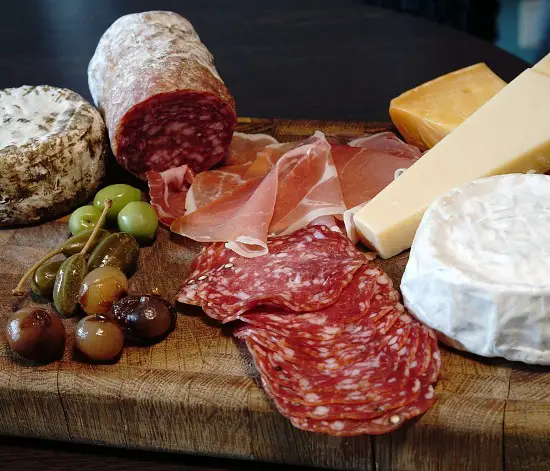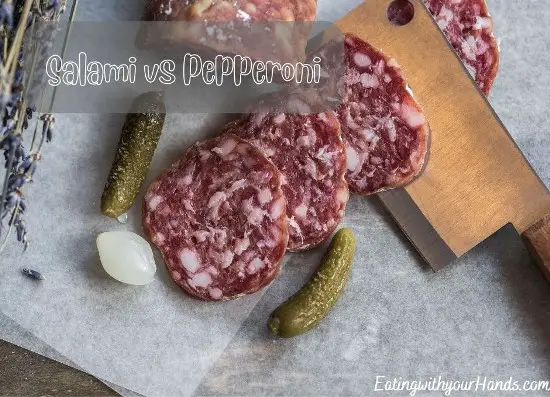If you have a penchant for sandwiches and pizzas, chances are you’re well-acquainted with the delightful duo of pepperoni and salami. These two deli meats play a starring role in an array of quick breakfasts and snack recipes.
While at first glance they might appear similar, a deeper dive reveals distinct differences in both taste and texture.
In this post, we’ll embark on a flavorful journey to uncover the nuances that set pepperoni and salami apart. Additionally, we’ll explore the versatile ways in which these savory delights can elevate an array of delectable recipes.
Table of Contents
What Is Pepperoni?

Pepperoni, a cherished pizza topping across the United States, is renowned for its bold flavor and satisfying chewiness. But have you ever pondered its origins and the intricate process that brings it to your plate?
Contrary to common belief, pepperoni isn’t an Italian salami. Instead, it’s a distinctly American creation with a touch of Italian influence. The term “pepperoni” finds its roots in the Italian word “peperone,” meaning bell pepper.
Pepperoni’s journey began in the early 20th century, crafted by the skilled hands of pizzerias and Italian butchers in America. During this period, pepperoni and cheese stood as the pinnacle of pizza toppings in the United States, often offered together in perfect harmony.
The Making of Pepperoni
In its traditional form, pepperoni involved a meticulous process. Ground pork and beef were blended with ground red pepper and spices, then stuffed into pig casings and air-dried or smoked at a gentle temperature.
Today, the essence of pepperoni remains intact as a smoked and air-dried product, originating from finely ground pork and beef. The meat is carefully seasoned with curing salts and additional spices, left to refrigerate for about three days. The mixture is then encased, packed with dried meat, and refrigerated for approximately 12 hours.
The sausages undergo suspension in a smoke room, a crucial step where the curing process imparts the signature red hue to pepperoni. This not only enhances its visual appeal but also safeguards it against microbial spoilage, including the potential threat of botulism. The entire production timeline spans a few weeks, ensuring a perfectly crafted pepperoni.
Variations of Pepperoni
Pepperoni’s allure extends beyond its classic form. Various enticing variations include garlic, cayenne pepper, and paprika in the mixture, contributing to the distinct and zesty flavor profile.
Is Pepperoni Healthy?
While pepperoni boasts complete proteins, minerals, and B vitamins, its nutritional merits must be weighed against its high fat and salt content. Laden with sodium, sugar, artificial flavors, additives, saturated fat, and calories, moderation is key.
The curing process not only imparts that tangy taste and chewy texture but also introduces nitrates. While these compounds are integral to the preservation process, excessive consumption may pose health risks. Thus, savoring pepperoni in moderation, as part of a well-rounded diet, is the recommended approach for those indulging in this savory treat.
>>Learn more: Why is Pepperoni so Greasy? and Difference between Pepperoni and Sausage?
What is Salami?

The genesis of salami traces back to ancient times, where ingenious individuals discovered that curing meat with salt and an array of spices could significantly prolong its shelf life.
However, it was during the Roman era that salami began to adopt the characteristics that define it today. In this bygone era, salami artisans utilized wild game meats such as venison, wild boar, and even ostrich in their craft.
Over time, salami evolved into a culinary masterpiece, finding a special place in the hearts of Italians. Each region of Italy contributed to the salami narrative by crafting its unique variations, employing different meats, spices, and preparation techniques.
How is Salami Made?
The art of making salami involves the meticulous process of grinding different meats, often a blend of pork, beef, or both, along with a symphony of spices like black pepper, fennel, garlic, and paprika. This delectable mixture finds its home inside a casing, crafted from either animal intestines or synthetic materials.
Left to cure, the duration of this process can span from a few weeks to several months, depending on the specific type of salami. During this curing period, the meat mixture undergoes a transformative journey, losing moisture and acquiring a luxurious, savory flavor that defines the essence of salami.
Types of Salami
Salami, with its myriad types and flavors, offers a culinary adventure for every palate. From the distinguished Genovese Salami to the rustic charm of Cacciatore, the indulgent Lardo, the bold notes of Chorizo, the timeless Soppressata, to the familiar favorite Pepperoni, there’s truly something for everyone.
Whether thinly sliced for an elegant appetizer, adorning a pizza with its savory presence, or enjoyed in its pure form, salami stands as a genuine culinary delight, a testament to the artistry and diversity of Italian cuisine.
>>Also read: Can You Eat Raw Salami? and What is the black stuff in salami? Learn more…
> What is The Difference Between Summer Sausage and Salami?
The Differences Between Salami and Pepperoni

In this exploration of popular cured meats, we delve into the intricacies of pepperoni and salami, dissecting the differences in their ingredients, taste, texture, and the diverse ways they can be relished.
Ingredients of Pepperoni and Salami
Pepperoni, a delectable amalgamation of pork and beef trimmings, boasts a medley of spices, including paprika, chili pepper, garlic, fennel, cayenne pepper, white pepper, and anise seed.
The addition of salt and sodium nitrite serves as crucial curing agents, imparting the iconic bright red hue to this savory treat.
Should manufacturers opt for turkey as a substitute, it must be explicitly labeled as “turkey pepperoni,” while beef-only variations bear the label “beef pepperoni.”
On the flip side, salami finds its essence in a blend of pork, beef, veal, and occasionally poultry. Seasoned with grainy black pepper, powdered garlic, vinegar or white wine, and salt, salami also incorporates nitrates to safeguard the meat from potential spoilage.
Taste and Texture Differences
Pepperoni, renowned for its spicier profile, draws inspiration from the fiery salamis of Southern Italy. Additionally, a hint of smokiness enhances its character.
In contrast, salami can verge on the spiceless spectrum, offering a diverse taste profile. Furthermore, while pepperoni often presents a fine-grained and softer texture, salami can exhibit variations in texture depending on the specific type.
Ways to Enjoy Salami and Pepperoni
Salami finds its place as a beloved addition to a cold antipasto platter, elevating the experience with its rich flavors. Its versatility shines as it enhances the taste of various dishes, from soups and pasta sauces to eggs, pizzas, and refreshing salads.
Conversely, pepperoni claims its fame as the quintessential pizza topping. Its crispy and curly edges contribute a delightful crunch to the pizza experience.
Beyond pizza, pepperoni’s culinary prowess extends to other dishes, such as sandwiches, wraps, and salads, where its savory charm can be equally appreciated.
Conclusion
In the grand tapestry of cured meats, whether you savor the nuanced flavors of salami or the bold spiciness of pepperoni, both promise a gastronomic journey that transcends the ordinary.

Fernando is the creator and writer behind the food blog Eating with your Hands. Living and working in cities like Paris, Barcelona, and Berlin, and being married to a Canadian foodie, has given Fernando a passion and interest in food and inspired him to run EWYH.
